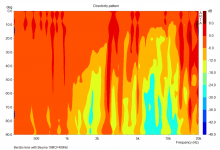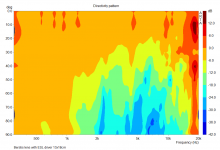Could there be acoustic low-pass in the lens as well to reduce resonances?🙂
In a horn, the volume of air between the diaphragm and the horn throat acts as a low pass filter. That's why the phase plug on a compression driver is so close to the diaphragm, to minimize that low pass filter.
Same thing happens here.
That's also why I use those slot shaped taps on my Unity horn projects, I do that to make the area constant, also to minimize the low pass effect.
TLDR: the answer to your question is "yes" 🙂
So for a mid range driver there could be a lens that sets desired (widened) dispersion around crossover to tweeter and acts as a low-pass to reduce resonances higher up. Cool! The lens looks a bit ugly though 🙂
Now, the thing that's *really* interesting here, is that it can obviously be reversed: you could design a lens that takes a *spherical* wavefront - like a tweeter - and turns it into a *planar* wavefront - like a ribbon. You could also vary the pathlengths to get a diverging or converging wavefront.
Meyer Sound do something similar to what you propose here with their Ribbon Emulation Manifold:
US6668969B2 - Manifold for a horn loudspeaker and method
- Google Patents
I just saw an article about a 3D printed "noise cancelling metamaterial."
Boston Engineers 3D Print Open Noise-Cancelling Metamaterials | All3DP
I didn't find the published paper about it (if there is one), but from looking at the photo, it appears to be just like one outside row of my acoustic lens with a longer delay path and with a hole in the center. I think the idea is that the outside ring delays to sound wave enough so it can destructively interfere with the wave coming straight through the center hole. This would mean that it only works at certain frequencies and therefore not useful for absorbing sound inside a speaker cabinet, for example.
Boston Engineers 3D Print Open Noise-Cancelling Metamaterials | All3DP
I didn't find the published paper about it (if there is one), but from looking at the photo, it appears to be just like one outside row of my acoustic lens with a longer delay path and with a hole in the center. I think the idea is that the outside ring delays to sound wave enough so it can destructively interfere with the wave coming straight through the center hole. This would mean that it only works at certain frequencies and therefore not useful for absorbing sound inside a speaker cabinet, for example.
Of course this principle has been tried many times before, as alluded to in previous posts.
Always the problem has been with the resonant cavity such a large amount material in the "speaker grille", results in.
Perhaps that could be helped a lot by bringing the whole structure a lot closer to the diaphragm. Millimeters is my guess to be sure, just above x-max.
In fact you could almost turn the whole thing around and put the protruding part inside the concave cone of the diaphragm.
Also, even dispersion of most frequencies in the vertical, is usually not needed or even wanted.
if you only needed dispersion horizontally, it would take us right back to the old slanted plate lens.
That can be implemented in two ways:
Plates with equal inclination and edge length, but a concave cutout.
The original problem with that one AFAIK, was again the resonant cavity, which could as mentioned, possibly be helped by getting the plates a lot closer to the diaphragm.
Or, the sectorial horn approach, also in previous post mentioned.
Only the sectorial horn should probably have more sections with differing lengths and distribution.
Is plastic really the best material? Might thin paper cardboard not be better? It's thin, stiff, and has a broad resonant frequency, hence why it is used for the actual diagram often.
Always the problem has been with the resonant cavity such a large amount material in the "speaker grille", results in.
Perhaps that could be helped a lot by bringing the whole structure a lot closer to the diaphragm. Millimeters is my guess to be sure, just above x-max.
In fact you could almost turn the whole thing around and put the protruding part inside the concave cone of the diaphragm.
Also, even dispersion of most frequencies in the vertical, is usually not needed or even wanted.
if you only needed dispersion horizontally, it would take us right back to the old slanted plate lens.
That can be implemented in two ways:
Plates with equal inclination and edge length, but a concave cutout.
The original problem with that one AFAIK, was again the resonant cavity, which could as mentioned, possibly be helped by getting the plates a lot closer to the diaphragm.
Or, the sectorial horn approach, also in previous post mentioned.
Only the sectorial horn should probably have more sections with differing lengths and distribution.
Is plastic really the best material? Might thin paper cardboard not be better? It's thin, stiff, and has a broad resonant frequency, hence why it is used for the actual diagram often.
Last edited:
I just saw this thread and thought hey this sounds familiar.
Last week I spent a bunch of time reading about Beveridge speakers because lately I've been interested in electrostatic speakers.
I'm not a horn/lens guy and I'm sure you'll say I'm wrong but isn't what you're talking about similar to the Beveridge lens?
Last week I spent a bunch of time reading about Beveridge speakers because lately I've been interested in electrostatic speakers.
I'm not a horn/lens guy and I'm sure you'll say I'm wrong but isn't what you're talking about similar to the Beveridge lens?
I just saw this thread and thought hey this sounds familiar.
Last week I spent a bunch of time reading about Beveridge speakers because lately I've been interested in electrostatic speakers.
I'm not a horn/lens guy and I'm sure you'll say I'm wrong but isn't what you're talking about similar to the Beveridge lens?
Yes it's exactly the same principle. And it doesn't necessarily have anything to do with horns.
I understand it doesn't necessarily have anything to do with horns. It is a waveguide not a horn.
Janszen used a Venetian blind guide like the JBL one but they put it on electrostatic panels on the Z2CF model.
Janszen used a Venetian blind guide like the JBL one but they put it on electrostatic panels on the Z2CF model.
How about using this way of bending the sound to match the exit of our compression drivers to almost any horn entry angle imaginable.
Take the BMS 4550 for example, it has a 14 degree exit and from what I read it produces almost a plane wave at the exit.
Feels like the perfect candidate for experimentation if we can make the channels small enough to not introduce to much of a negative effect on the highest frequencies.
Take the BMS 4550 for example, it has a 14 degree exit and from what I read it produces almost a plane wave at the exit.
Feels like the perfect candidate for experimentation if we can make the channels small enough to not introduce to much of a negative effect on the highest frequencies.
Berstis lens with various drivers:
- Manger MSW
- Beyma 10MCF400Nd as in Berstis' article
- Faital 5FE120
- ESL 13x18cm
Attachments
- Home
- Loudspeakers
- Multi-Way
- Berstis Lens




